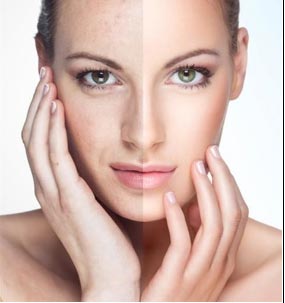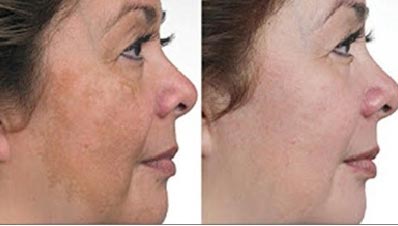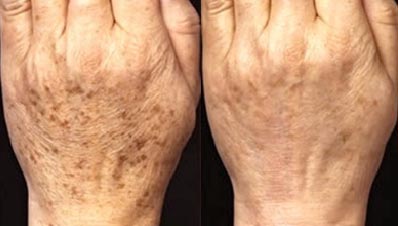

Brown and red spots are some of the most common signs of aging on your skin
Treat your unwanted pigmentation with Dr. Jay’s Laser Medi Spa
What are Age and Sun Spots?
Age spots are flat, brown, gray, or black spots on the skin. They vary in size, and usually appear on the face, hands, shoulders, and arms. Typically on sun-exposed areas of the skin. Age spots are also referred to as liver spots, senile lentigo, solar lentigines, or sun spots. Age/Sun spots are completely harmless and do not require any treatment. However, for cosmetic reasons, age spots can be lightened to provide a more youthful appearance.
What causes Age Spots?
Age spots are the result of an excess production of melanin, or skin pigment. Even doctors don’t always know the underlying reason why age spots are developed. Skin aging, sun exposure, or other forms of ultraviolet (UV) light exposure, such as tanning beds, are all possible causes. You’re most likely to develop age spots on the areas of your skin that receive the most sun exposure such as:
Who is at Risk for Age Spots?
People of any age, sex, or race can develop age spots. However, age spots are more common in people with certain risk factors such as:
How are Age Spots Treated?
Age spots are not dangerous and don’t cause any health problems. Treatment isn’t necessary. However, some people may want to remove the age spots solely for cosmetic reasons.
With that said, after a lifetime of being exposed to the sun, you’re bound to have multiple consequences including brown spots on your hands and face. Age spots, technically known as solar lentigines are brown or grayish pigments. Age spots, despite its name is not only caused by age, but rather from sun damage.
Dermatologists may prescribe bleaching creams to help fade the age spots gradually. They usually contain hydroquinone, with or without retinoids such as tretinoin. Bleaching creams usually take several months to fade age spots. Additionally, you’ll need to wear sunscreen at all times during this treatment. Bleaching and tretinoin creams make your skin more sensitive to ultraviolet (UV) damage.
There are several medical procedures that can treat age spots. However, medical procedures carry a risk of side effects. Before deciding on a medical treatment, consult your provider as to which treatment is the most appropriate for your skin. Medical procedures for age spots include:
Always wear a broad spectrum sunscreen after treatment to protect your skin from ultraviolet (UV) damages.
How to Prevent Age Spots?
Unfortunately, you can’t always prevent age spots. However, you can reduce your chances of developing them with proper maintenance. While it’s hard to avoid age spots in their entirety, there are several preventive steps you can take to help reduce your risk. You can’t change your skin’s ability to combat the effects of the sun, but you can minimize the degree of sun exposure.
What are the Results of Age Spot Treatments?
Age spots are a common skin care concern, but they’re both preventable and treatable. Be responsible about sun exposure and sun protection.

Before and After Images of Age Spot Treatments
